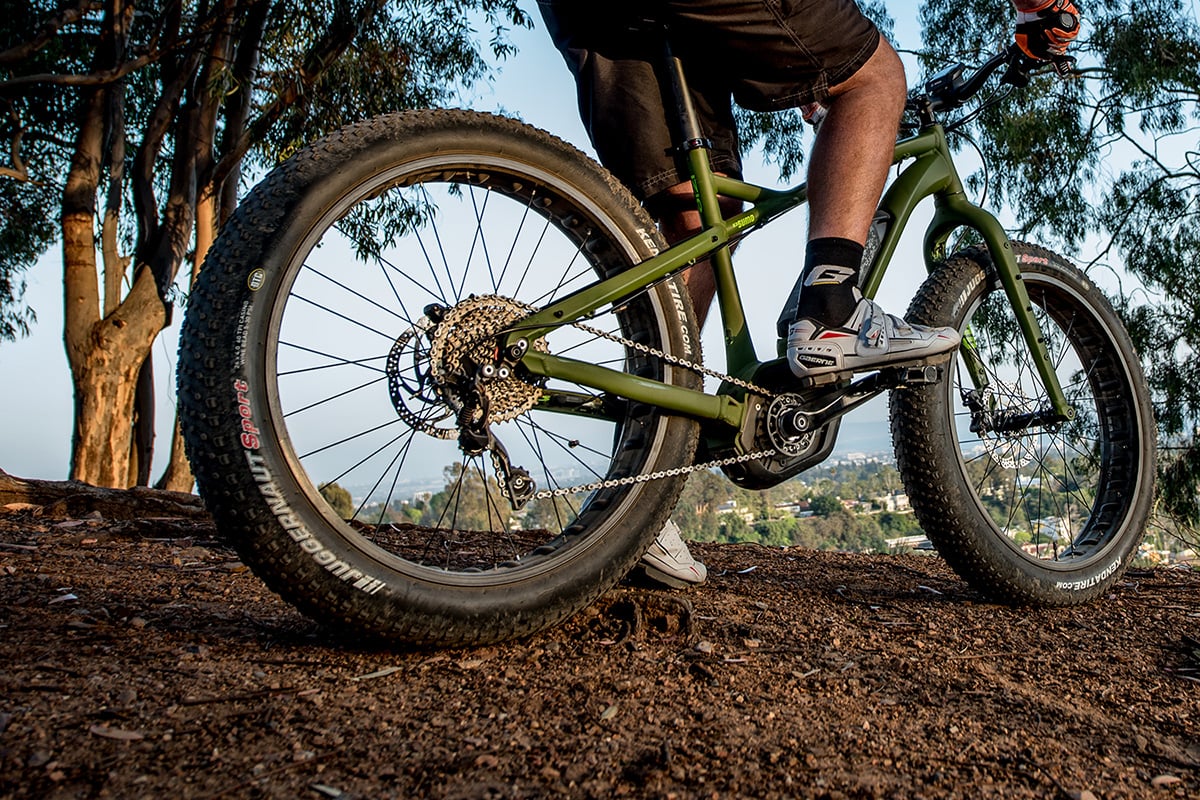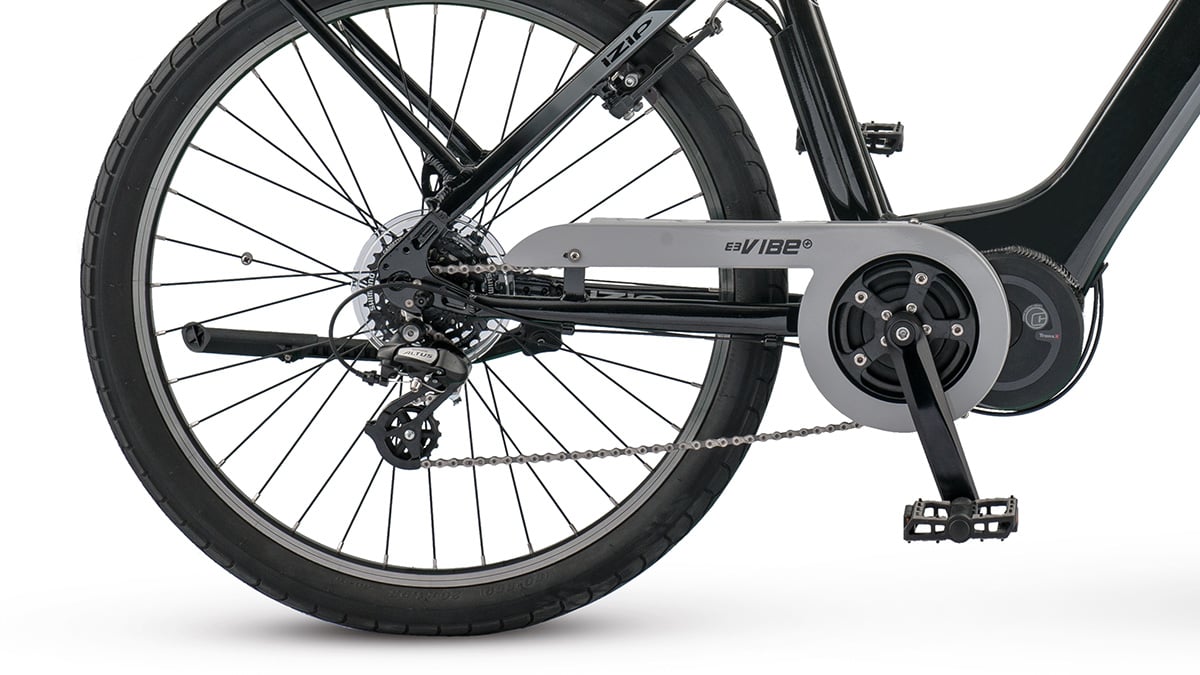Based on the location of the drive system, electric bikes can be differentiated into two main groups. Hub motors are built into and power one or more of the wheels, while Mid-Drive motors that power the crank are attached to the frame (which is engineered specifically to be electrified).
Hub Motor Electric bikes can utilize either a front or rear wheel motor, and in a few instances, might even have both. In general terms, hub motors are generally less expensive and work pretty well, but they are less convenient and can be problematic when compared to mid-drive motors.
Front hub motors have a tendency to spinout on loose or wet terrain because there isn’t much weight over the front of the bike, while rear hub motors tend to be back heavy, especially if the battery is located over the rear wheel. Rear hub motors are generally preferred, but all hub motors have many disadvantages, and very few advantages:
- Hub motors don’t put any added strain on the bikes chain.
- Hub motors are generally less expensive.
- Hub motors make it more difficult to remove the wheel to repair a flat tire.
- Wheels with hub motors are heavy and if the wheel, rim or spokes become damaged due to a road hazard such as a pothole or a curb, a replacement wheel is more costly to repair or replace.
- Hub motors require wiring a power cable and, due to location, can be problematic and add to the difficulty in removing the wheel.
- Electric bikes with hub motors use many non-standard bike parts.
- Hub motors generally require a higher wattage motor for comparable performance to a lower wattage mid-drive motor. High wattage consumes more of your battery and lowers range.
- Hub motors cannot be geared to adjust their RPM as the bike speeds up on a descent or slows down on a climb, causing them to be less efficient in these situations.
Hub motor electric bikes work best on flat ground or light rolling hills.

Mid-Drive Motor Electric bikes have a frame that is specifically designed and engineered to incorporate the motor, placing the weight low and centered, while allowing it to power the bike’s chainring directly. Mid-drive designs also have the distinct advantage of utilizing the bike’s standard drivetrain to provide variable gearing ratios. Bottom line: Mid-Drive motors have many advantages and very few disadvantages:
- Ideally balanced – weight is low centered between both wheels.
- Smooth and predictable power – sensor technology housed inside the mid-drive actuates the motor in perfect harmony with your own pedal input.
- Greater efficiency, longer range – because you can power the bike through its own drivetrain, you have a multi-speed transmission that maximizes the use of stored energy, both yours and the battery pack’s.
- Higher torque – motor power is rated in wattage but it’s torque, not wattage, that is the needed turning force, which helps you accelerate and climb hills. Torque is measured in Newton meters (Nm) and the very best hub motors have a torque rating of 40 Nm while mid-drive systems can easily reach 60 to 70 Nm. More torque = easier climbing.
- Mid-drive electric bikes use standard bike parts, making it easier and less costly to maintain your electric bicycle.
- Easy to remove wheels to fix a flat or load into a car.
- Mid-drive systems ride and feel more like a normal (acoustic) bike.
- Mid-drive systems are coming down in price as they have benefited from technology trickling down market. You can buy an IZIP electric bike with a mid-drive system today for under $2000.
Retrofitted or “Kitted” Electric bikes are built by replacing parts on an existing bike with an electric drive system (either a hub motor or mid-motor) along with a battery pack and user interface that can be attached to most bikes. There are a number of aftermarket kits available today which can convert almost any type of bike to an electric bike, but there are some significant risks and downsides:
- Normal (acoustic) bikes are engineered to be exclusively human powered and not designed to withstand the added weight and stress of an electric drive system.
- Modifications usually void the bike’s warranty.
- Kitted bikes don’t ride as well as purpose-built electric bikes.
- If you decide to purchase a kit, make sure that the Lithium battery pack and charger carry a valid UL number and certificate for safety. Also make sure that you are purchasing from a legitimate company located in North America, which carries sufficient products liability insurance, and have it installed by a qualified mechanic at a local bike shop.
Pedal-assist Versus Throttle-operated Electric bikes
How the motor is actuated on an electric bike is important to understand and experience before you decide which electric bike to buy. All electric bikes operate either through throttle mode (much like a scooter or motorcycle), pedal-assist mode (which uses sensors to read your pedal cadence or, in some systems, sensors that read how much force you’re applying to the pedals), or a combination of both modes.

Pedal-assist allows activation of the motor only through your pedaling input. As you pedal and turn the cranks, the motor adds a proportionate boost that you can control through the system’s power assist level while you ride (usually three to five power settings). The latest generation of quality electric bikes deploys sensor technology that processes data through a tiny onboard microprocessor that communicates with the motor to add just the right amount of assist in perfect harmony with your pedaling. In the higher power settings, pedal-assist requires only light pedaling to provide a significant boost and most riders find that it negates any need for a throttle. IZIP electric bikes with pedal-assist systems,provide an amazing, smooth and predictable feeling of power – all you, just stronger!
Throttle activated systems power the motor by twisting the grip or pushing a thumb-tab/boost button on the handlebars. This is the simplest and least expensive activation system, which causes the electric bike to operate much like a motorbike or scooter rather than a bicycle. You can pedal along with the motor if you wish or not pedal at all. Some riders find this helpful in certain scenarios when you need a boost or you’re carrying a heavy load to get started. The downside of a throttle control is that it draws current from the battery pack very quickly and rapidly reduces your range. Throttles can also be dangerous in certain situations. If they are accidently triggered, the bike can take off unexpectedly. And electric bikes with throttles are restricted in some places so it is important to check your local regulations. At IZIP, we do not offer throttle only activated electric bikes, but we do offer a boost button option on certain models.
Pedal-Assist with Boost – Most electric bike riders today prefer the pedal-assist mode once they spend some time on their bike learning how to use the variable gearing along with the power settings, but sometimes a little boost is just what the doctor ordered. That is why we have an optional Boost Button that is easily installed and works with all of our IZIP electric bikes using TranzX drive systems, which are found on many of our recreation and utility models.





